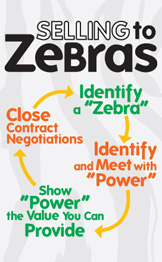INSIDER: Selling to Zebras
By: Heather McLeod, MBA Candidate
How successful are you at closing sales? In their book, Selling to Zebras, Jeff Koser and Chad Koser use an analogy of a hunt in the African savannah as the key to selling success. Salespeople are like lions that need to find zebras in order to survive. "[Lions] won't swipe at any food source within sight ... and then pursue another and another until all their energy is spent and they have to abandon the hunt. Rather, they pursue prey that is worth the energy to pursue" (Koser and Koser, p. 5).

Think Point #1: Traditional selling methods are rapidly becoming outdated and unproductive
While it might sound extreme, most companies only close about 15% of their sales. This means that 85% of the time, salespeople are unsuccessful, and they are spending time trying to build a sale that does not come to fruition. What has worked in the past for salespeople will not work in today's environment and hard work alone is not enough to be successful. "Old-school methods targeting sheer volumes of leads and knocking on every door with equal vigor have been proven ineffective, not to mention too expensive. Effort alone is no longer enough to be competitive" (Koser and Koser, p. 6).
Think Point #2: What is a zebra?
Zebras are perfect prospects - they are the ideal fit for a salesperson's deal, not just in terms of the product or service, but also in terms of values. Understandably, the first key to identifying zebras is to know your company. When you know your company and what you can offer your potential customers, you can begin to identify your target zebras. Sales personnel should be able to answer each of these questions. An inability to answer "yes" to these questions means the individual may not be a prospect at all!
- Will this prospect buy anything?
- Will this prospect buy from me?
- Will this prospect buy more?
Think Point #3: Analyzing the characteristics of past customers can help to determine what your best targets are for future customers
Identifying past "best" customers can offer insight into any similar characteristics that may exist between them. Then, you can identify these same characteristics in potential customers. This becomes the profile of your ideal zebra. The questions you should think about are:
- How did these customers behave during the sales cycle?
- Were they open, inviting, honest and forthright, or was it difficult to communicate with them?
- Were contract negotiations smooth and uneventful, or tense and tiresome?
- Were you able to position and sell all that you offer?
Think Point #4: It is essential to identify and schedule a meeting with the person who is "Power" for your zebra
"Power" is the person with decision-making power who defines the company's business issues, who is responsible for the promises that will get the project approved and for achieving and reporting the end results. This is the person that you should be targeting with your sales pitch. After you have spotted your zebra, it is essential to meet with Power. It can be difficult for salespeople to get appointments with Powerful decision-makers. The following approach is proven to work in today's highly competitive pursuit for Power's time:
- Uncover the names of executives who might be power
- Send an email to at least three potential power-level contacts to pave the way
- Mention the other two executives you are pursuing in all communications
- Conduct a voice-mail campaign, leaving something of value with each message
- Prepare an executive brief you can send, if necessary
Think Point #5: In your meeting with "Power," show the value you bring to the table for your zebra
Once you get a meeting with "Power", it is essential that you are able to clearly communicate two points: the mutual COST of the value verification, and WHEN "Power" can expect to see results. Up to this point is the hardest part of the process. From here, it's time to prove your value and close your zebra. During the meeting to close with "Power," you must discuss the before-and-after process, the value you are able to verify, your solution (through a road map that shows financial savings), and a commitment from "Power" to do business. Contract negotiating is the final stage - after you have already shown your solution's value. This allows you to leverage the economic value you have proven that you add for your zebra. But, the signing of the contract is not the end of your relationship with your zebra. It is important that you make sure to force success. This means that the implementation plan you designed with your client needs to provide them with the success you guaranteed. You also need to be available to address any problems or issues that arise for your zebra. By using the zebra buying cycle techniques as presented by Jeff and Chad Koser, the salespeople within your organization will feel empowered to challenge and significantly contribute to sales and sales strategy decisions, thus producing more results and receiving higher commissions while performing fewer demonstrations.
. . . . . . . . . . . . . . . . . . .
Recommended Reading
Koser, Jeff, and Chad Koser (2009), Selling to Zebras: How to Close 90% of the Business You Pursue Faster, More Easily, and More Profitably, Austin, TX: Greenleaf Book Group.
. . . . . . . . . . . . . . . . . . .
About The Author
Heather McLeod, MBA Candidate, May 2010
Baylor University Graduate Assistant, Keller Center for Research
Heather is a third-semester graduate student from New Braunfels, Texas. She earned her BBA with a double major in marketing and management from Baylor University.